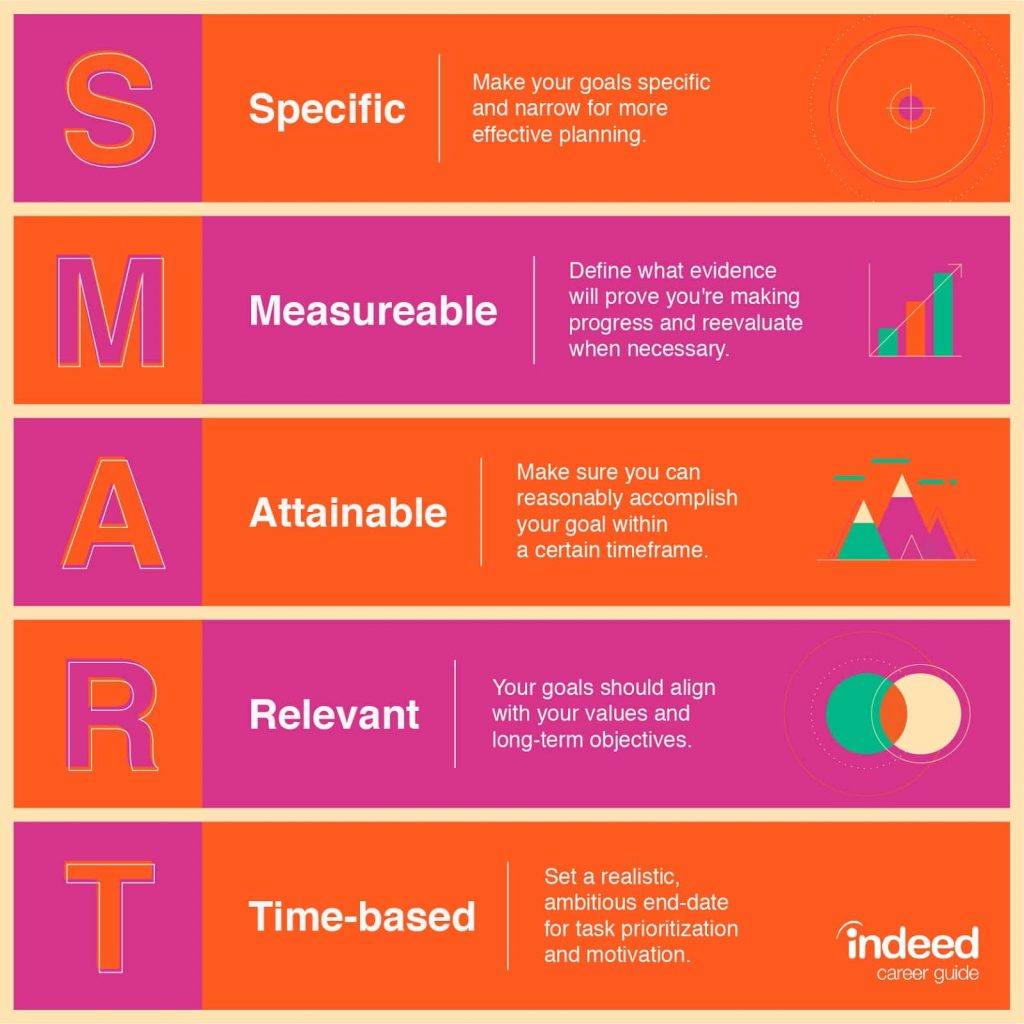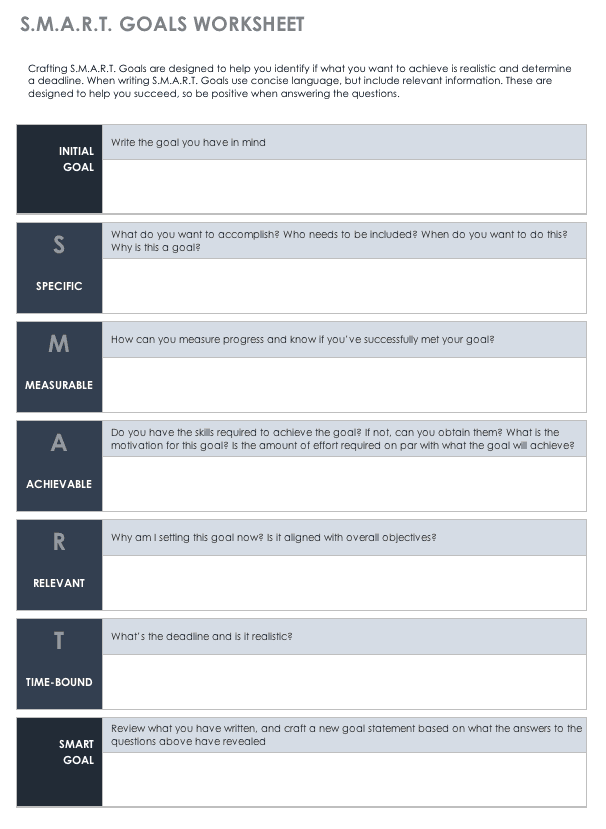Setting goals is the first step towards achieving anything. You can only plan if you have a steady goal in mind. You have to define the end before you arrange the means, and you have to do it the smart way. Hard work is good, but working smart is the key to success.
In the year 1981, this theory was given more meat by George T Doran, former Director of Corporate Planning, Washington Water Power Company. He published a paper named “There’s a SMART way to write management’s goals and objectives.” Only, the smart goals that he was thinking, were a tad more elaborate than the literal meaning we understand. Doran introduced the concept of SMART goals, thus charting out steps and criteria for achieving an organization’s objectives.
But let us start from the very beginning.
What is a ‘goal’?
In its simplest definition, a goal is an idea of the future or the desired result that a person or a group of people envision, plan, and commit to achieving.
But think about the last time you set a goal for yourself and achieved it within the time frame you thought you would. Sometimes the goals that we set personally or with a group of people we work with are too ambitious or too vague.
We end up setting a goal that none of us is able to measure, making it less relevant and harder to qualify as achieved.
For example, setting a goal like 100% growth in the business is great. Now if you’re achieving it over a year, you’re really accomplishing something. But if you’re achieving that same goal only over a span of 10 years, you’re probably going too slow.
While it makes sense to have yearly goals, creating long-term goals that span out over a decade is less relevant. Think about the number of times the market needs to change and how you’ll need to adapt to all those changes. That way your path to reaching the goal you just set will always keep changing. To make it worse, you can easily add a few more months or years to achieving the goal with the dynamics changing constantly.
Now having a strategic direction is great. But classifying that as a goal is not effective. You can’t measure the progress of your vision.
That’s where setting SMART goals come in. In this article, we’re sharing why the SMART goals framework has proven to work for individuals. We’ve also included SMART goal examples for work that you can use to set your professional goals.
But before we delve into how you can get started with SMART goals, here’s a quick video by the venerable John Doerr of Kleiner Perkins (who in fact wrote the book on doing OKRs – “measure what matters“) on the secret to success by setting the right goals:
You can learn more about what Bill Gates thinks of the book and the goal settings process on his blog, Gates Notes.
What does the acronym SMART stand for?
The SMART acronym stands for Specific, Measurable, Attainable, Relevant, and Time-Bound.
What is a SMART Goal?
A SMART goal is a specific, measurable, achievable, and relevant goal. What differentiates this goal-setting framework from others is its laser-focused specificity. A SMART goal defines itself and always defines what achieving it means.
What do SMART Goals mean?
The “SMART goals” is a framework that guides you towards setting up objectives that really move the needle. The SMART Goals acronym stands for:
S – Specific
M – Measurable
A – Achievable
R – Relevant
T – Time-bound
If you look closely, SMART goals are nothing but perfect traits that any of your goals should have. These are the things that you should have in mind while conceptualizing a goal for you or your organization. These are the five most practical and important characteristics of a goal.

Let’s delve deeper into each aspect of SMART goals, with relevant examples.
SMART Goal Step 1: S – Specific Goals
This is the first step towards writing a smart goal, and there are five questions that you need to ask yourself while designing a specific goal:
Who will be the ones involved?
What is going to be accomplished?
What will this goal achieve?
When will the goal be achieved?
Why do you want to achieve this goal?
If you can successfully answer all the aforementioned questions without any doubt, then you have a specific smart goal in mind.
SMART Goal Step 2: M – Measurable Goals
Just like the first step, you not only need your smart goal to be specific, but measurable as well. For that, you need to ask yourself the following questions:
How many or how much is this goal going to achieve?
Is there any way I can measure my success/failure on my way towards my goal?
How will I come to know whether I have achieved my goal or not?
It is important to quantify your progress and know the numbers. While figuring out your goals is a smart thing indeed, knowing the path towards achieving them is better. That is only possible if you have the answers to the aforementioned questions. You have to quantify your goals and measure your progress periodically.
SMART Goal Step 3: A – Achievable Goals
You can aim for the moon, but do you have the resources for it? It is no use of setting a dream smart goal if it is more of a dream than a goal. You need to be practical enough to ascertain whether or not you are equipped to achieve your smart goal. You need to further ask yourself these questions:
Do you have the resources to achieve the goal? If not, how can you achieve them? Is it a practical recourse? Does the end outweigh the means?
Has this been done before?
Now, the second question is not that important. If you will wait for someone else to take the step, you can miss out on being the first one to achieve it. However, the first set of questions is extremely important. To achieve smart goals, you need to ask yourself smart questions. Make sure that you know exactly what you are getting into, and that you are equipped to achieve it.
SMART Goal Step 4: R – Realistic and Relevant Goals
This smart goal step complements the above-mentioned one. You have to be realistic in your approach to achieving a goal. As we said, one can hope for the moon, but only those who have the means and resources to land there can turn that dream into action. Your smart goal needs to be realistic, in terms of approach and achievement.
It also needs to be relevant. You need to see whether it aligns with the vision of your organization. Starting new things and expansion is good, but it needs to be a branch of an already existing vision and not a cumbersome addition.
Ask yourselves the following questions:
Is your SMART goal realistic?
Does your goal look relevant?
Is it realistically achievable with the current resources and timelines?
Can you commit to it?
If the answer to the aforementioned is “Yes,” then you are on the right path towards achieving your smart goal.
SMART Goal Step 5: T – Time-bound Goals
Make sure you have dates in mind; a start date and a finish date. Every race has a finish line, even the one towards your goal. Imagine if there was any race without an ending line. It would have been total chaos, leading to the wastage of energy of the participant and resources of the organizer. The same holds true for smart goals as well. No matter how ambitious your smart goal is, you need to set a realistic timeline for it and allocate resources accordingly.
SMART goals examples for work

Any technique looks exemplary on paper. It is only when it is executed, that we realize the effectiveness of it. Smart goals are no different. Take a look at some smart goals examples to understand the framework better.
Example: You have 100 products. So you set a goal to sell 40 products in one month on an eCommerce platform.
Is it specific?
Yes, you want to sell 40 products in one month and your smart goal is clear.
Is it measurable?
You know when you will have 100 products to sell. With that information, you also know when you can upload these 100 products to your store.
Now you have to sell 40 products out of these 100 products in 30 days. So on average, you’re to sell a minimum of 1 product every day. So your goal is measurable – you know what to do every day.
Is it achievable?
While you can have specific and measurable statistics in your head, you need to practically think about whether your numbers are achievable. Whether the goal is achievable depends on the baseline, how many products did you sell in a comparable timeframe in the past. If you sold 5 products in the 30 previous days, then selling 40 now seems daunting but if the baseline was 30, then selling 40 seems ambitious yet achievable. The idea is to make sure you are not setting yourself up for failure.
Is it realistic/relevant?
Will the income be more than the cost involved? Can you promote it online and offline? At the end of it all, will the end justify the means? If you were trying to sell 100 products in just 30 days, you may have had to add more budget to promoting the products.
Relevant also means that if you achieve the number of 40, then that’s the right thing to do for the business. For example, if out of the 100 products, 99 are priced at $1 and the hundredth product is priced at $100, then perhaps the target should be more dollar-oriented instead of volume-oriented.
How much time will it take to show results?
This is perhaps the most important question. You should know when to stop. Every model should have segments, instead of being one never-ending one. Set a timeline of sale. When should you have an inventory of products ready when the current lot is sold out.
In this example, you’re trying to sell 40 products first in one month. So as they get sold out, you still have 60 more products in your inventory that you can sell in month two. And in case the number of orders increases in month one, you still have stock to fulfill those.
The SMART goal framework is only smart when you know how to ask the right questions to induce the right results.
A SMART goals template: The easiest way to write SMART goals
A perfect SMART goal template is one that is easy to grasp and flexible enough for tweaks. It should be such that it does not intimidate and should rather educate. The best SMART goal template is one that is free of jargon and can be implemented in various business schemes and scenarios with slight changes.
Here is an easy SMART goal template that will help you plan your smart goal well for effortless execution.

Why are SMART goals important?
SMART goals are important because they give your goals a required structure. Goals look tempting in a blueprint, but seldom turn out to be achievable in an exact manner. This is where the smart goal setting comes into play. It ensures that your goals receive the exact energy and focus that is required, and not anything over that. It also ensures a defined schedule that enables the employees to work towards achieving the smart goal, without any stress.
Smart goal framework makes sure that the employees working towards the goal are in the right frame of mind, with sharper focus. It induces self-discipline and drives the importance of prioritization.
Smart goal infrastructure ensures transparency to the entire goal-setting process, tightening it.
Another thing to note is that Smart goal infrastructure can vary. The acronym over time has been adapted and interpreted in different ways. Although it largely still means the same thing. Some of the most common and acceptable variations are:
S – Simple, Sincere, Strategic, Straight Forward
M – Manageable, Motivating
A – Adaptable, Ambitious, Attainable
R – Reliable, Result-oriented, Recordable
T – Time Relatable, Tangible, Team Building
One can pick and create your own combination which works best for the brand and organization. At the end of it all, your smart goal framework should enable you to create a structure that can achieve your smart goal in time.
SMART Goals Framework: The drawbacks you need to overcome
While understanding the SMART goals framework, it is important to be aware of its shortcomings. You can get a jump on them so you can nip them in the bud.
- Smart goals framework can lead to an addiction to goal setting and not the actual process of achieving it. These can lead to far-fetched ideation and meetings which do not lead to any fruitful effect.
- The smart goals method can also lead to addiction towards the feeling of ultimate achievement, often at personal costs. Make sure your employees do not fall into that trap.
- Mental health is of utmost importance while setting smart goals. Goal setting and subsequent working towards it often drive the possibility of failure out of the minds of those who are working. This should not be the case. Every action can lead to both success and failure and the ones working towards the goal should know it. Else, they can suffer from severe mental health issues. Learning to cope with not achieving the goal, is also important.
Do you need a SMART goals framework for your organization?
The answer is, yes. The Smart goals framework does have some cons, but the pros outweigh them. If you answer all the questions right at the start and set your goals right, within your means, and measurable, the framework would work perfectly for you. You can achieve the goal and even if you do not end up achieving it completely, the whole framework will add a positive outlook.
There is the old adage that “what gets measured gets done” and the S.M.A.R.T. goals framework encapsulates the statement perfectly. It brings you and everyone else on the same page as to what exactly needs to be done, what would be the quantified outcome, and what is the timeline for doing the same.
The two likely reasons why most goals don’t get done is that they were never relevant, to begin with, or they were so ambitious that they were not realistic. S.M.A.R.T. goals steer you clear of the pitfalls of goal settings and helps you to construct the goals at the right level of detail so that you have the best shot at achieving your goals.
Now that you know how to set your goals, it’s time to modernize your attendance and time tracking solutions by bringing it to where work happens – inside Slack, Microsoft Teams, or Google Hangouts Chat.
Take AttendanceBot for a whirl in your workplace and watch how your team works together more effeiciently to achieve all the SMART goals set.




